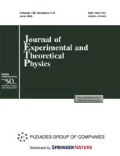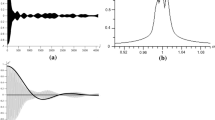Abstract
An investigation based on the coupled Maxwell-Bloch equations for a system of equivalent exchange-coupled spins is performed in order to explain a number of features of NMR spectra obtained in metals by Fourier-transforming of the free-induction decay at ultralow temperatures. Small angles of tilting of the nuclear magnetization by the exciting rf field are considered. It is shown that the free precession inherits the nonuniformity in the distribution of the rf field and the magnetization produced at the excitation stage inside the sample on account of the skin effect. As a result, the NMR spectrum is found to consist of a set of peaks—signals due to standing spin waves. However, such a spectrum can be observed only when the detuning of the exciting rf field is sufficiently large relative to the Larmor frequency of the spins. Otherwise, the rf field does not penetrate into the sample because of strong absorption by the spins. If the detuning is large, the dispersion signal and part of the NMR absorption signal are proportional to the equilibrium magnetization to the power 3/2. Such behavior is expected at low temperatures so that the coupling of the magnetization with the rf field is strong. The results obtained qualitatively explain the experimentally observed characteristics of the NMR spectra: the presence of kinks and structure of the NMR lines, the dependence of the shape and intensity of the spectrum on the detuning of the exciting rf field, and the nonlinear dependence of the nuclear susceptibility on the reciprocal of the sample temperature.
Similar content being viewed by others
References
G. Eska in Proceedings of the Conference on Quantum Fluids and Solids, edited by G. Ihas and Y. Takano, Gainesville, Florida, USA, 1989, AIP Conf. Proc. No. 194 (1989), p. 316.
W. Baeuml, G. Eska, and W. Pesch, Physica B 194–196, 321 (1994).
J. Leib, M. Huebner, S. Goetz, Th. Wagner, and G. Eska, J. Low Temp. Phys. 101, 253 (1995).
A. I. Akhiezer, V. G. Bar’yakhtar, and S. V. Peletminskii, Spin Waves, North-Holland Pub. Co., Amsterdam, 1968 [Russian original, Nauka, Moscow, 1967].
C. Kittel, Phys. Rev. 110, 1295 (1958).
J. Winter, Magnetic Resonance in Metals, Clarendon Press, Oxford, 1971.
A. I. Tikhonov and A. A. Samarskii, Equations of Mathematical Physics, Pergamon Press, New York, 1964 [Russian original, Nauka, Moscow, 4th edition, 1972].
A. Abragam, The Principles of Nuclear Magnetism, Clarendon Press, Oxford, 1961 [Russian translation, Inostr. Lit., Moscow, 1963].
Yu. S. Karimov and I. F. Shchegolev, Zh. Éksp. Teor. Fiz. 41, 1082 (1961) [Sov. Phys. JETP 14, 772 (1962)].
Author information
Authors and Affiliations
Additional information
Zh. Éksp. Teor. Fiz. 114, 1836–1847 (November 1998)
Rights and permissions
About this article
Cite this article
Khutsishvili, K.O., Fokina, N.P. & Eska, G. NMR spectra under skin-effect conditions at ultralow temperatures. J. Exp. Theor. Phys. 87, 996–1002 (1998). https://doi.org/10.1134/1.558751
Received:
Issue Date:
DOI: https://doi.org/10.1134/1.558751




